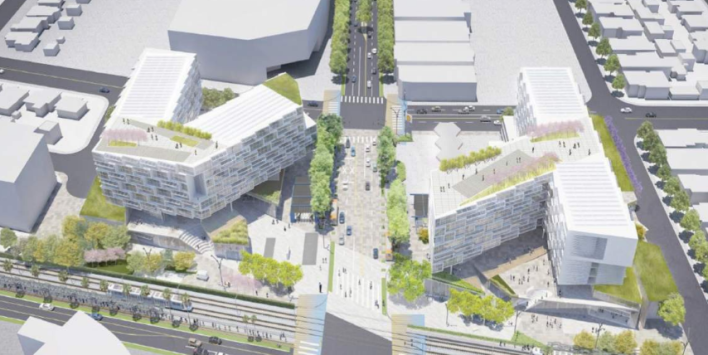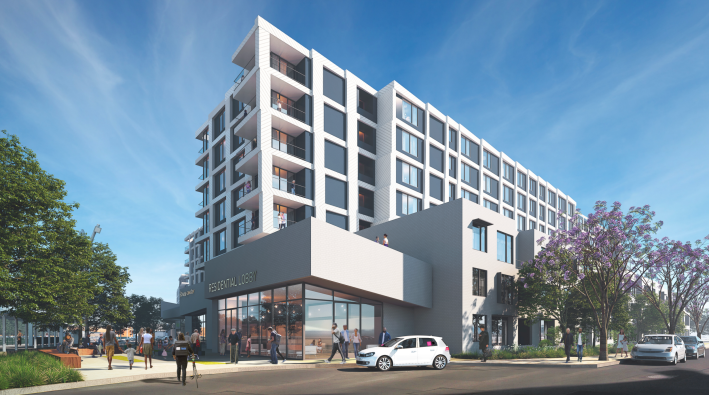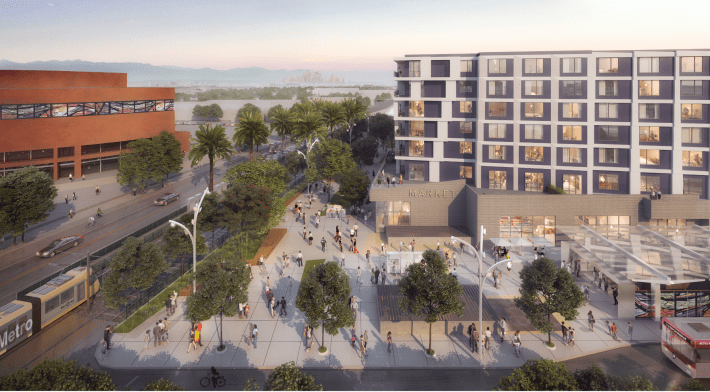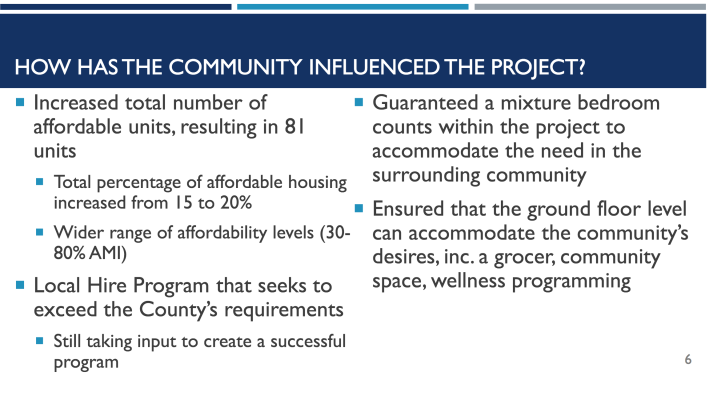Wednesday morning, Crenshaw Crossing - the mixed-use housing project planned for Metro- and county-owned lots at Exposition and Crenshaw - will go before the Planning and Programming Committee of the Metro Board. Not for final project approval, but for a 12- to 16-month extension of the Exclusive Negotiation Agreement (ENA) that would allow the developer to "fully entitle and environmentally clear the project with [the city] and finalize the Joint Development Agreement and Ground Lease terms" with Metro and the county.
If ultimately approved by the full board and county board of supervisors, WIP-A, LLC, a subsidiary of Watt Companies, will spend the next year completing the entitlements process, getting environmental clearance, cobbling together project funding sources, and, in partnership with the West Angeles Community Development Corporation (WACDC) and Metro, consulting with the community. Assuming the final plans would be approved in the spring of 2021, construction would begin later that summer and be completed in 2023, according to the timeline proposed in a presentation last month.
The project is about a year behind schedule, according to the timeline Watt Companies laid out in September of 2018.
But the project has also changed significantly since Watt was first awarded an interim ENA back at the end of 2017.

Although Watt was already an investor in the South L.A. area, it had not effectively built relationships with local partners that would help ground the project in the existing community. [Renderings of the project - see below - that almost entirely erased the Black community from a site that essentially serves as a gateway to the city's historic Crenshaw corridor did not help in that regard.]
Because Metro's Transit-Oriented Communities policy asks developers to incorporate community-based organizations as partners in the planning process, Watt has since brought WACDC on to serve as co-owner and co-developer of the project. Though the WACDC's role is not clear from the Crenshaw Crossing website, the Letter of Intent both organizations signed last year indicated WACDC would assist with the outreach, marketing, and lease-up of the affordable units as well as with providing services to the tenants in the affordable units.

And although the Crenshaw Crossing project had beat out three other proposals at the time, including one submitted by the WACDC, it had offered less in the way of affordable units.
It now offers more affordable housing - 20 percent instead of 15 - but fewer units overall, dropping the original 492 planned to 400 (and including more three-bedroom units in that final count). And while the amount of retail space to be offered has also dropped from 47,500 square feet to 40,000, the project prioritizes the inclusion of a grocery store.
The project also promises to incorporate local hire, although that is still being worked out.The question of affordable housing remains a significant point of contention.
Housing prices have shot up along the Crenshaw corridor over the last few years in anticipation of the arrival of the Crenshaw/LAX Line, and major projects planned along the boulevard have fought hard to limit the number of affordable units they need to include.
At Slauson, Billionaire Jeff Greene's plans to raze Dorset Village's 206 garden apartments and build 782 units in their place currently only include 141 affordable units (fewer than the required number, given that the units he will demolish are rent-controlled). Meanwhile, the city attorney continues to try to deny Nipsey Hussle's business partners the ability to go forward with their plans (which include an affordable housing project) at the site of The Marathon.
At King, the Baldwin Hills Crenshaw Plaza makeover is reluctantly offering ten percent of its 961 planned units as affordable (with only five percent reserved for those at or below 50 percent area median income), while the troubled District Square project* on Obama Blvd. (and just across the street from the Crenshaw Crossing site) is expected to have 577 market-rate units and zero affordable units. Sprinkled in between are smaller proposed projects offering a handful of affordable units here, there, and at the Liquor Bank. [*An appeal launched by Damien Goodmon of the Crenshaw Subway Coalition regarding the lack of affordable housing in the District Square project will be heard this (Tuesday) afternoon. See details here.]

Given that this project will sit on publicly-owned land and given that the minimum income requirements needed to qualify for the project's "affordable" units would still render them beyond the reach of much of the surrounding community, critics have argued that a project that is mostly market-rate has the potential to contribute to the displacement and erasure of the (already) rapidly dwindling Black community. At the very least, many have argued, the project should have a much higher percentage of affordable units.
The Crenshaw Subway Coalition, has gone farther, calling for the project to be 100 percent affordable and for Watt Companies' contract to be cancelled.
Watt has been reluctant to budge.
As seen in a back-and-forth between Goodmon and Jennifer McElyea, Senior Managing Partner and co-head of Watt Investment Partners, Watt's defense continues to be that community feedback had originally been in favor of a market-rate project.
Technically, she's not wrong.
Thanks to segregation, some of the city's wealthiest Black residents share the corridor with some of its poorest. And thanks to disinvestment, rich and poor alike have long been forced to go outside their communities for entertainment or to shop for groceries or see their other needs met. The wealthier inhabitants, in particular, are ready to finally see their dollars respected and to have access to the amenities they have clamored for for years - things they know an affordable housing project generally can't provide or help attract to the area.
The fact that South L.A. is already home to so many affordable housing projects coupled with the assumptions associated with them - that they serve poor or troubled folks, rather than regular working people and families earning between $22,000 and $83,500 a year - means putting an affordable project at a prominent site can also make it feel like the community is being passed over for investment yet again.

The trouble is, in part, that these projects are usually weighed in isolation.
Disconnected from the larger set of changes happening along the corridor, it can make sense to try to get the most out of a project like the one that Watt proposes.
But for better or worse, there are now a handful of projects slated for nearby sites that should provide some of the amenities folks have been asking for, taking the pressure off public agencies to use publicly-owned land fill that gap.
Which means this might be the right time for Metro and the county to reconsider how best to ensure a gateway to a historic Black corridor actually preserves space for the people that made it so special.
The Planning and Programming Committee meets tomorrow at 11 a.m.. Find the agenda here and the board report here.
*****
For more background on the project, see our previous coverage on the Expo/Crenshaw lots below:
- November, 2017: When Your Renderings Suggest the Black Population Has Been Abducted by Aliens, It May Be the Least of Your Problems
- November, 2017: Metro Executive Management Cmte. Approves Six-Month ENA for Proposed Expo/Crenshaw Development
- September, 2018: Project Planned for Lots at Expo/Crenshaw Takes Another Step Forward








